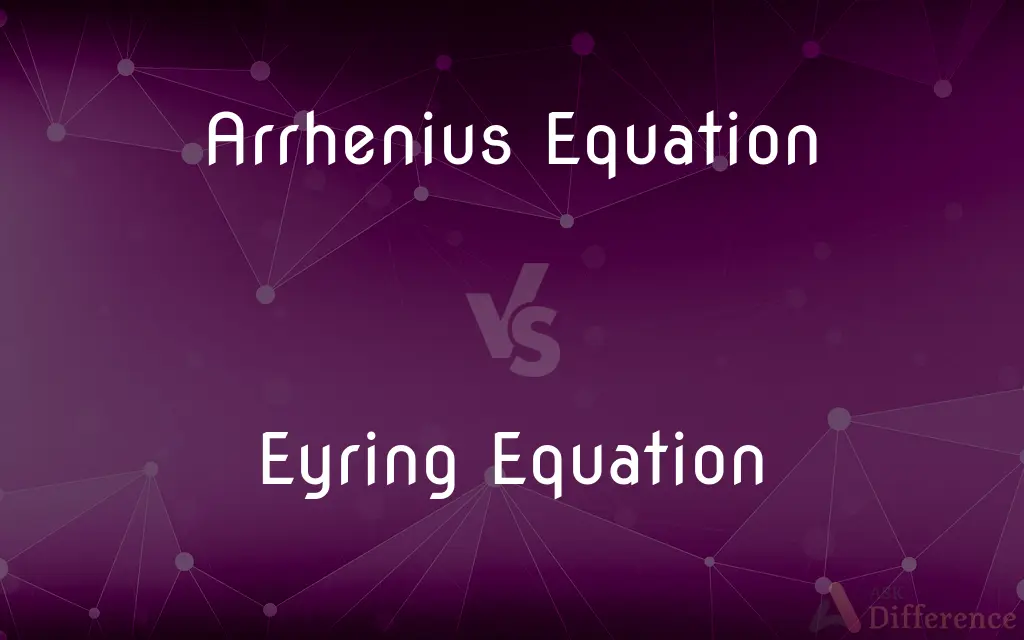Arrhenius Equation vs. Eyring Equation — What's the Difference?
By Tayyaba Rehman & Fiza Rafique — Published on February 6, 2024
The Arrhenius Equation relates reaction rate to temperature and activation energy, while the Eyring Equation, based on transition state theory, accounts for entropy and enthalpy of activation, offering a more comprehensive rate description.

Difference Between Arrhenius Equation and Eyring Equation
Table of Contents
ADVERTISEMENT
Key Differences
The Arrhenius Equation is pivotal in chemical kinetics, relating the rate constant of a reaction to the temperature and the activation energy, portraying how reaction rates increase with temperature. In contrast, the Eyring Equation, derived from the principles of transition state theory, offers a more comprehensive approach, incorporating the effects of temperature on the rate constant but also considering the enthalpy and entropy of activation, reflecting the energy and disorder related to the transition state of the reaction.
While the Arrhenius Equation is widely used for its simplicity and for providing an intuitive understanding of how temperature influences chemical reactions, it is somewhat limited by its assumptions, particularly at higher temperatures. The Eyring Equation, however, applies to a broader temperature range and gives insight into the molecular level by factoring in the changes in enthalpy and entropy that occur as reactants transition to the activated complex.
The parameters of the Arrhenius Equation, specifically the pre-exponential factor and the activation energy, are empirical and often determined experimentally. These parameters indicate the frequency of collisions and the energy barrier that must be overcome for a reaction to proceed. On the other hand, the parameters in the Eyring Equation are theoretically grounded in statistical mechanics, providing a more fundamental understanding of reaction rates by relating them to the potential energy surface of the molecular system.
In practice, the Arrhenius Equation is commonly used for its simplicity in fitting experimental data and predicting reaction rates at different temperatures. However, for reactions where changes in entropy play a significant role, or where a more detailed molecular understanding is needed, the Eyring Equation is preferable, offering a deeper insight into the mechanism and the energy profile of the reaction.
In summary, while the Arrhenius Equation is a cornerstone in the study of reaction kinetics, offering a clear and simple relationship between temperature and reaction rate, the Eyring Equation provides a more nuanced and detailed perspective, making it invaluable in the study of complex reactions where temperature, enthalpy, and entropy significantly influence the reaction pathway and rate.
ADVERTISEMENT
Comparison Chart
Theoretical Basis
Empirical; based on observed reaction rates and temperatures.
Derived from transition state theory and statistical mechanics.
Parameters
Activation energy and pre-exponential factor.
Enthalpy and entropy of activation, alongside the Boltzmann and Planck constants.
Temperature Dependency
Simplified; assumes exponential increase in rate with temperature.
Detailed; accounts for entropic and enthalpic contributions to reaction rate.
Applicability Range
Generally limited to lower temperature ranges.
Applicable across a wide temperature range, including very high temperatures.
Insight into Reaction
Provides rate information based on temperature and activation energy.
Offers detailed insight into reaction mechanism, including energy and disorder of the transition state.
Compare with Definitions
Arrhenius Equation
Arrhenius Plot Analysis
Arrhenius plots of ln(rate constant) versus inverse temperature help determine activation energies.
Eyring Equation
Molecular Interaction Understanding
Using the Eyring Equation helps chemists understand molecular interactions during chemical reactions.
Arrhenius Equation
Activation Energy Dependency
The Arrhenius Equation highlights the exponential dependency of the reaction rate on activation energy.
Eyring Equation
Transition State Theory
The Eyring Equation, based on transition state theory, accounts for the enthalpy and entropy of the activated complex.
Arrhenius Equation
Empirical Model
The Arrhenius Equation, an empirical relationship, has been foundational in understanding chemical kinetics.
Eyring Equation
Temperature and Rate Constant
According to the Eyring Equation, both temperature and the energy of the transition state influence the reaction rate.
Arrhenius Equation
Temperature Relation
According to the Arrhenius Equation, increasing the temperature results in an exponentially faster reaction rate.
Eyring Equation
Reaction Mechanism Insight
The Eyring Equation provides insights into the reaction mechanism, beyond what the Arrhenius Equation offers.
Arrhenius Equation
Reaction Rate Prediction
Chemists use the Arrhenius Equation to predict how a reaction rate will change with temperature.
Eyring Equation
Enthalpy and Entropy Contribution
The Eyring Equation considers both enthalpy and entropy changes, detailing the reaction pathway.
Common Curiosities
What does the Arrhenius Equation predict?
It predicts how the rate of a chemical reaction changes with temperature. Specifically, it quantifies the exponential relationship between rate constant and temperature.
What is the Arrhenius equation used for?
It is used to predict reaction rates, optimize reaction conditions, and understand temperature-dependent reactions in various fields, including chemistry and biology.
What is the Arrhenius Equation?
The Arrhenius Equation is a mathematical formula that describes the relationship between the rate constant of a chemical reaction, temperature, and the activation energy.
What does the activation energy (Ea) represent in the Arrhenius Equation?
Activation energy represents the minimum energy required for reactant molecules to overcome the energy barrier and initiate a chemical reaction.
What are the key components of the Arrhenius Equation?
The key components are the rate constant (k), the activation energy (Ea), the gas constant (R), and the absolute temperature (T).
Who proposed the Arrhenius Equation?
Svante Arrhenius, a Swedish chemist, proposed the Arrhenius Equation in 1889.
How does temperature affect reaction rates according to the Arrhenius Equation?
Increasing temperature increases the rate of reaction exponentially, as shown by the exponential term in the equation.
What is the Eyring Equation?
The Eyring Equation is a mathematical model that extends the Arrhenius Equation to include the effects of both temperature and pressure on reaction rates.
How does the Eyring Equation differ from the Arrhenius Equation?
The Eyring Equation accounts for pressure (in addition to temperature) and provides a more comprehensive description of reaction rate changes.
Can the Eyring Equation be applied to all chemical reactions?
While it is a powerful tool for many reactions, the Eyring Equation may not be suitable for extremely complex reactions or those involving significant changes in volume.
What are the main components of the Eyring Equation?
The Eyring Equation includes the rate constant (k), the activation enthalpy (∆H‡), the gas constant (R), absolute temperature (T), and pressure (P).
How is the Arrhenius Equation represented mathematically?
Mathematically, it is represented as: k = Ae^(-Ea/RT), where k is the rate constant, Ea is the activation energy, R is the gas constant, T is temperature, and A is the pre-exponential factor.
What does ∆H‡ represent in the Eyring Equation?
∆H‡ represents the activation enthalpy, which is the energy barrier that reactant molecules must overcome for a chemical reaction to occur.
Who proposed the Eyring Equation?
Henry Eyring, an American chemist, introduced the Eyring Equation in the mid-20th century.
When is the Eyring Equation particularly useful?
The Eyring Equation is particularly useful when studying reactions under high-pressure conditions, such as in industrial processes.
Share Your Discovery

Previous Comparison
Flip Flop vs. Latch
Next Comparison
Dhirubhai Ambani vs. Ratan TataAuthor Spotlight
Written by
Tayyaba RehmanTayyaba Rehman is a distinguished writer, currently serving as a primary contributor to askdifference.com. As a researcher in semantics and etymology, Tayyaba's passion for the complexity of languages and their distinctions has found a perfect home on the platform. Tayyaba delves into the intricacies of language, distinguishing between commonly confused words and phrases, thereby providing clarity for readers worldwide.
Co-written by
Fiza RafiqueFiza Rafique is a skilled content writer at AskDifference.com, where she meticulously refines and enhances written pieces. Drawing from her vast editorial expertise, Fiza ensures clarity, accuracy, and precision in every article. Passionate about language, she continually seeks to elevate the quality of content for readers worldwide.
















































